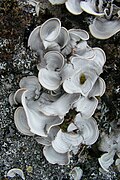Hygrophoraceae
| Hygrophoraceae | |
|---|---|

| |
| Hygrophorus eburneus | |
| Scientific classification | |
| Domain: | Eukaryota |
| Kingdom: | Fungi |
| Division: | Basidiomycota |
| Class: | Agaricomycetes |
| Order: | Agaricales |
| Family: | Hygrophoraceae Lotsy (1907)[1] |
| Type genus | |
| Hygrophorus Fr. (1836)
| |
| Genera | |
|
Acantholichen | |
The Hygrophoraceae are a
Taxonomy
History
The family Hygrophoraceae was first proposed by Dutch botanist
In his major and influential revision of the Agaricales, however,
Current status
Recent
Habitat, nutrition, and distribution
The majority of species in the Hygrophoraceae are ground-dwelling, though a few (such as
Species are nutritionally diverse.
Members of the Hygrophoraceae are distributed worldwide, from the tropics to the subpolar regions. Over 400 species have been described to date.
Economic usage
Fruit bodies of some
-
Humidicutis lewelliniae
References
- ^ a b Lotsy JP. (1907). Vorträge über botanische stammesgeschichte, gehalten an der Reichsuniversität zu Leiden. Ein lehrbuch der pflanzensystematick (in German). Vol. 1. Jena: Gustav Fischer. p. 706.
- ^ .
- ^ "Hygrophoraceae | COL". www.catalogueoflife.org. Retrieved 2023-06-30.
- ^ Rea C. (1922). British Basidiomycetaceae: A Handbook of the Larger British Fungi. Cambridge, UK: Cambridge University Press. p. 799.
- ^ Singer R. (1951) [1949]. "The Agaricales (Mushrooms) in Modern Taxonomy". Lilloa. 22: 5–832.
- ISBN 978-0-85198-885-6.
- ISBN 978-90-6191-971-1.
- ISBN 978-0-85199-377-5.
- ^ Bon M. (1990). Flore mycologique d'Europe 1: Les Hygrophores (in French). Amiens Cedex: CRDP de Picardie. p. 99.
- ^ PMID 17486974. Archived from the original(PDF) on 2016-03-03.
- ^ PMID 19646529.
- S2CID 84829857.
- S2CID 318326.
- ISBN 978-92-5-105157-3.
- ^ Dugan (2011), pp. 76–78.
- ^ Dugan (2011), p. 44.
- ^ Dugan (2011), p. 88.
Cited literature
- Dugan FM. (2011). Conspectus of World Ethnomycology. St. Paul, Minnesota: American Phytopathological Society. ISBN 978-0-89054-395-5.
- Lodge DJ, Padamsee M, Matheny PB, Aime MC, Cantrell SA, Boertmann D, et al. (2014). "Molecular phylogeny, morphology, pigment chemistry and ecology in Hygrophoraceae (Agaricales)" (PDF). Fungal Diversity. 64 (1): 1–99. .




